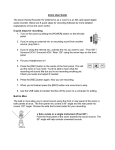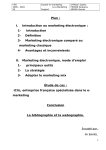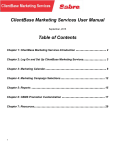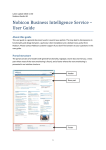Download 10 Steps to Online Networking Success
Transcript
10 Steps to Online Networking Success By Dana Lynn Smith, excerpted from The Savvy Book Marketer's Guide to Successful Social Marketing www.AuthorSocialMarketing.com 10 Steps to Online Networking Success by Dana Lynn Smith Online networking is a terrific way to build your expert status and promote yourself and your book. This special report, excerpted from The Savvy Book Marketer's Guide to Successful Social Marketing, outlines ten ways to develop and implement a successful online networking strategy. 1. Define Your Objectives The first step in developing your networking strategy is to pinpoint who you are trying to reach. You will probably have several different target audiences, such as: • Your peers and other authors and experts in your field • Influencers (bloggers and others who can recommend you) • Potential joint venture partners • Current and potential customers • Vendors and suppliers • Publishing and book marketing professionals Next, think carefully about what you are trying achieve. There are many potential benefits to online networking, such as • Meeting and learning from other people in your field • Driving traffic to your website and blog • Increasing your opt-in subscriber list • Finding joint venture partners • Getting speaking engagements or consulting customers © Dana Lynn Smith www.SavvyBookMarketer.com 2 • Promoting your books and other products and services • Improving search engine optimization and search results ranking 2. Avoid Common Networking Mistakes Here are some common online networking mistakes that you should avoid: • Diving in without a plan. • Joining too many networks or sites. Be selective about what communities you join and who you network with. • Spending too much time on networking, while neglecting your other work. • Sending out friend invitations on social networks with no introduction. At least 90 percent of the friend invitations that I receive on Facebook have no introduction at all. I click through to their public profile, to try to get an idea of who these people are and why they would want to befriend me. But on most profiles you can’t see much information unless you are already friends with the person. It’s important to always introduce yourself when meeting strangers online, just as you would in person. • Trying to "sell" on networking sites. It’s okay to subtly promote your products, but don’t give the impression that you are just there to sell. That will turn people off fast. • Making it "all about you" rather than reaching out to add value to others. • Failing to observe common courtesies. Be polite in your communications and thank people who help you. 3. Protect Your Privacy When you join a new online community, locate the privacy settings page and adjust the settings to your comfort level. Nick O'Neill has written an © Dana Lynn Smith www.SavvyBookMarketer.com 3 excellent article about privacy settings for Facebook, and some of these tips are applicable to other sites as well. http://www.allfacebook.com/2009/facebook-privacy. It’s a good idea to share some personal information in your online profiles, like listing your hobbies or favorite authors, to help people learn a little about you and help them find something in common with you. But be careful about posting too much personal information, like your full date of birth, your kid’s names, or the fact that you are leaving on vacation tomorrow. Just use common sense. And, remember that things posted online never really go away. Don't post anything you wouldn't want your kids, customers, colleagues, or potential employers to see. 4. Manage Your Time Wisely Online networking can take up a huge amount of time if you’re not careful. Here are some tips for managing your time: • Develop a strategy before you begin. • Prioritize your networking tasks, so that you concentrate most of your time on the most important things. • Don't join too many networks or communities. • Avoid checking your networks first thing in the morning. It’s easy to get sucked in and spend way too much time there, instead of tackling your highest priority tasks for the day. • Develop a routine and set aside a specific amount of time each day for networking. That way you'll get it done, but you won't be overwhelmed. • Look for timesaving tools and applications, but don't waste time playing with "gee whiz" applications that don't improve your productivity. • Evaluate your progress regularly and make adjustments to your strategy. © Dana Lynn Smith www.SavvyBookMarketer.com 4 5. Measure Your Networking Success Measure your networking progress so that you know what’s working. Be sure to install a statistics counter, such as Google Analytics or Stat Counter, on your blog and website. Record important metrics each month. A spreadsheet is ideal for this. Here are some useful metrics to track: • Friends or followers on social networks • Comments and guest posts on other blogs and forums • Number of business contacts • Subscribers to your mailing list and blog • Visitors to your website and blog • Inbound links to your website and blog • Search engine rankings for your top keywords • Alexa ranking and Google PageRank for your websites • Sales of books and other products and services. Also, create a contact database in Outlook, Excel, or a contact management system to keep track of your most important business contacts. 6. Network Through Blogs Networking with bloggers that cater to your target audience or topic can be really valuable. Use search tools to locate bloggers, then study their sites to get a feel for what they do. Here are some good places to search: • Google Blog Search http://blogsearch.google.com © Dana Lynn Smith www.SavvyBookMarketer.com 5 • Technorati http://technorati.com/ • My Blog Log http://www.mybloglog.com • Google http://google.com (search for keyword + blog) Subscribe to the RSS feeds of relevant blogs and make comments on posts where you can add value to the conversation, but don't be selfpromotional in your comments. Each time you make a comment, you are building your expert status and creating a link back to your site. Also, contact other bloggers suggesting ways that you might work together. Don’t send a generic “would you like to trade links” email—make it personal. One good way to introduce yourself is to genuinely compliment the blogger on their site and ask if they would be interested in having you provide a guest post. Once you’ve made contact, then you can suggest other ways you might work together to your mutual benefit, but don’t be pushy. How are some ways that you can cross-promote with other bloggers: • Contribute content to each other’s blogs or ezines. • Do joint teleseminars and promote through affiliate programs. • Link to each other's sites. • Do reviews of books or other products • Participate in virtual blog tours. • Promote each other on Twitter. 7. Build Your Expert Status in Online Forums Forums are free online communities where people who are interested in a particular topic can ask questions and get answers. These are some good places to search for relevant forums: • Yahoo Groups http://groups.yahoo.com © Dana Lynn Smith www.SavvyBookMarketer.com 6 • Google Groups http://groups.google.com • Google http://www.google.com (search for keyword + forum) • Search for a keyword on Google, then click on Show Options (near the upper left) and then click on Forums. Here are some tips for using online forums: • You get more exposure from larger and more active forums, so check the group size and number of posts on the forum's website. • Read the forum's rules and lurk for a few days before you post, to get a feel for the level of expertise and the group's etiquette. • When you sign up for a forum, look for a settings area where you can specify that you want a daily digest of posts to the group, rather than receiving an email every time someone makes a post. • Participate regularly for maximum benefit. • You can gain visibility by posting questions or answers, so be sure to post some questions in addition to providing answers. • After you post, check back to see if you need to respond to any replies that your post received. • Write a good signature line and add it to the bottom of all of your posts. Many groups limit the length of signature lines, so check the rules. Save your signature in a convenient place so you can copy and paste it as needed. • Be careful not to be promotional in your posts. Provide helpful information and let your signature promote for you. Check out these forums for authors and publishers: • Self Publishing http://finance.groups.yahoo.com/group/Self-Publishing/ • POD Publishing http://finance.groups.yahoo.com/group/pod_publishers/ © Dana Lynn Smith www.SavvyBookMarketer.com 7 • Publish-L http://groups.google.com/group/publish-l?hl=en 8. Choose the Right Online Networks Online networks are virtual communities where you create a profile with information about yourself, then invite friends to join your network and interact with them. Be selective about the networks you join and focus on those where your target audiences are most likely to be. The largest general networking sites in the U.S. are Facebook and MySpace, and they are referred to as social networks. Facebook is more suitable for business use and is very popular with entrepreneurs such as authors and consultants. Some other networks, such as LinkedIn, are more business oriented and are often called business or professional networks. There are numerous specialized networks that cater to a specific audience, such as Eons for baby boomers and PartnerUp for small business owners. Find specialized networks that cater to your audiences by using search engines and by entering keywords into the search box at www.Ning.com. You can also create your own network on Ning. Virtual reader communities are specialized networks for readers and authors, and they are especially valuable for fiction authors. See http://snipr.com/k9lmh for a list of other reader communities. 9. Use Online Networks Successfully When you join a network, take time to optimize your profile page by uploading a good quality photo, writing an effective bio, and looking for places to promote your book without appearing too commercial. Here are some other tips: • Send personalized friend/contact requests, explaining who you are and why you want to befriend the other person. • Keep in mind that you don't have to accept every friend request you receive. • Look for relevant groups to join, and be active in them. © Dana Lynn Smith www.SavvyBookMarketer.com 8 • Get involved in the community and add value to others. Become known as an expert in your area—the "go to" person for information and resources. • Many networks, including Facebook, offer a way to promote virtual and live events. Some also offer pay-per-click advertising. • Participate regularly, but don't be overly promotional. • Be generous in your praise of others. Publicly thank people who provide helpful resources, congratulate people on their successes, and compliment people who do excellent work. 10. Use Twitter Effectively Twitter is the most popular microblog. It's a cross between social networking and blogging where users post 140-character messages to their followers. The messages posted on Twitter are called tweets. When you sign up to "follow" other people, the messages posted by those people appear on your Twitter home page. Your messages appear on the home page of the people who are following you. Most people are baffled by Twitter at first, wondering why they would want to read a stream of messages about what other people are doing. If the people you are following are posting useless information, like what they ate for lunch, there would be no point in following them. But Twitter has evolved into a powerful communications tool and is being embraced by everyone from individuals and small businesses to major corporations. If you don't get it at first, dive in anyway and you will quickly understand what the buzz is all about. Set up an account, follow some people who interest you, and lurk for a couple of days to get a feel for the site before you start posting. Here are some tips: • For a Twitter user name, nonfiction authors should choose a topical name that reflects what they do, unless they are very well known. • Upload a good quality photo and write a good bio before you start following anyone. © Dana Lynn Smith www.SavvyBookMarketer.com 9 • Follow people that you want to follow you, and many of them will. • Don't just talk about yourself. Write interesting tweets that other people will want to re-tweet. When someone re-tweets your message, you get exposure to all of their followers. • Add value to others by linking to helpful articles and websites, introducing your colleagues and favorite books, and teaching minilessons. • Don't make too many self-promotional tweets—let other people promote you. This report was excerpted from The Savvy Book Marketer's Guide to Successful Social Marketing by Dana Lynn Smith. It includes additional tips for online networking, a 78-page user manual for Facebook and Twitter, and information on using other forms of social media such as video and content sharing sites and social news and bookmarking sites. See more information at www.AuthorSocialMarketing.com Save 20% on The Savvy Book Marketer's Guide to Successful Social Marketing Order your copy at www.AuthorSocialMarketing.com and enter the coupon code BSG623 in the coupon field at checkout. © Dana Lynn Smith www.SavvyBookMarketer.com 10 About the Author Dana Lynn Smith is a book marketing coach who specializes in developing marketing plans for nonfiction books. She has a degree in marketing and 25 years of experience, including 15 years in publishing. She also writes a Texas travel blog at www.TexasTravelGal.com Resources for Authors • Get free book marketing tips at the Book Marketing Maven blog www.BookMarketingMaven.com • Subscribe to The Savvy Book Marketer ezine at www.TheSavvyBookMarketer.com and get a free copy of my ebook, Top Book Marketing Tips. • The Savvy Book Marketer's Guide to Selling Your Book to Libraries guides you through the process of selling to libraries, start to finish. www.SellingtoLibraries.com • The Texas Book Marketing Handbook is packed with contact information for Texas libraries, bookstores, book fairs, newspapers, magazines, radio and television stations, and Texas-themed gift shops. You'll also get tips for selling to libraries, bookstores and specialty retailers; getting publicity; and selling books at book fairs. www.TexasAuthorResources.com Networking Connections • Friend Dana Lynn Smith on Facebook at www.facebook.com/DanaLynnSmith • Follow @BookMarketer on Twitter at http://twitter.com/BookMarketer for book marketing tips and resources. • Join the Savvy Book Marketing Group on Facebook at http://groups.to/savvybookmarketing © Dana Lynn Smith www.SavvyBookMarketer.com 11





























